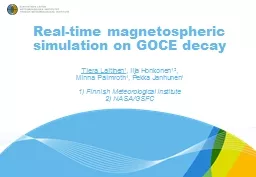

simulation on GOCE decay Tiera Laitinen 1 Ilja Honkonen 12 Minna Palmroth 1 Pekka Janhunen 1 1 Finnish Meteorological Institute 2 NASAGSFC GOCE decay and reentry ID: 790202
Download The PPT/PDF document "Real-time magnetospheric" is the property of its rightful owner. Permission is granted to download and print the materials on this web site for personal, non-commercial use only, and to display it on your personal computer provided you do not modify the materials and that you retain all copyright notices contained in the materials. By downloading content from our website, you accept the terms of this agreement.
Slide1
Real-time magnetospheric simulation on GOCE decay
Tiera Laitinen
1
, Ilja Honkonen
1,2
,
Minna Palmroth
1
, Pekka Janhunen
1
1)
Finnish
Meteorological
Institute
2) NASA/GSFC
Slide2GOCE decay and re-entry
GUMICSThe only European global magnetosphere-ionosphere simulation modelReal-time capable parallel version GUMICS-5Space weather effects in GOCE decayIncrease in the decay rate during space weather eventsDecay rate variations are well reproduced by GUMICS simulation and a simple
atmospheric density perturbation model.
Outline
Slide3Slide4Ran out of propellant 21 Oct 2013.Re-entered atmosphere 11 Nov near Falkland.
Re-entry gained wide media attention also in Finland.FMI launched a campaign to test real-time modelling of space weather effects on GOCE orbit.FMI supported Geodetic Institute in informing Finnish authorities on the satellite (LUOVA warnings)Information was also provided to ESA SSA/SST (debris surveillance and tracking)GOCE re-entry
Slide5There were no major
storms, but moderate geomagnetic disturbances occurred.The most interesting was 30 October.Space weather during GOCE decay
Slide6Real-time
space weather modelling
Slide7Global magnetosphere-ionosphere coupling
simulation modelThe only one of its kind in EuropeDeveloped at FMI since 1993Dozens of scientific publicationsMHD magnetosphereElectrostatic ionosphereGUMICS
Slide8GUMICS: magnetosphere
Slide9GUMICS: ionosphere
6.11.2014
9
Slide10GUMICS: M-I-coupling
Solar wind
J
‖
e
–
prec
.
Φ
Mapped
along
dipole
field
lines
:
B
,
n
,
T
,
v
, …
Φ
,
Σ
,
J
,
E
,
e
–
prec
.
, …
Slide11A new parallel version of the code
Currently under validation and finalisation.Capable of faster than real time runningwith moderate resolution, ~ 0.5 - 1 RErequires ~ 100 cores.First technical real time operations test was performed during the GOCE caseGUMICS-5
Slide12Chained run system
Solar wind propagation from L1 takes ~ 1 h.Allows ~ 20 min prediction time.
Initial
state
from
the
previous
run
Latest
solar
wind
from
ACE
Run
extended
beyond
measured
solar
wind
with
constant
input
New
run
every
20 min
Slide13GUMICS results
Real-time
simulations
were
done
with GUMICS-5.
Later
the
period
was
simulated
with GUMICS-4
with
better
resolution
.
Joule heating +
electron precipitation.Integral over 24 h(heat accumulation
).
Slide14From
Joule heating to air drag
Slide15A
toy model for heat depositionHeight [km]Extra heatfrom SWETemperaturechangeQuiet time atmospheric profiles from NRLMSISE-00JH from GUMICS
Assume
globally even
heat
distribution
Assume
heating
profile
with
maximum
at 120 km
Slide16Density increases above ~130 km
Atmospheric profileswithout and withionospheric heatingPressureDensityTemperature
Height
[km]
Height
[km]
Height
[km]
Slide17Extracting changes in decay
rateNominal decay rate in a time-invariant atmosphereReal decay rateSpace weather effect?
Decay
rate
[
km/orbit
]
Nominal
density
at
orbit
from
NRLMSISE-00
Fit
to the
real
decay
rate
(get air drag coefficient)Fitted density is the nominal
decay
rate
Calculate
difference
of
real
and
nominal
decay
rate
Slide18Simulation predicts orbit variations
Slide19Global MHD simulation predicts
variations in GOCE decay rate.This analysis was done afterwards, but the procedure could be implemented as a forecast routine (with forecast time ~ 20 min).The forecast time could be lengthened with solar wind data froma measurement sunward of L1 an accurate solar wind
simulation
.Conclusions & discussion
Slide20